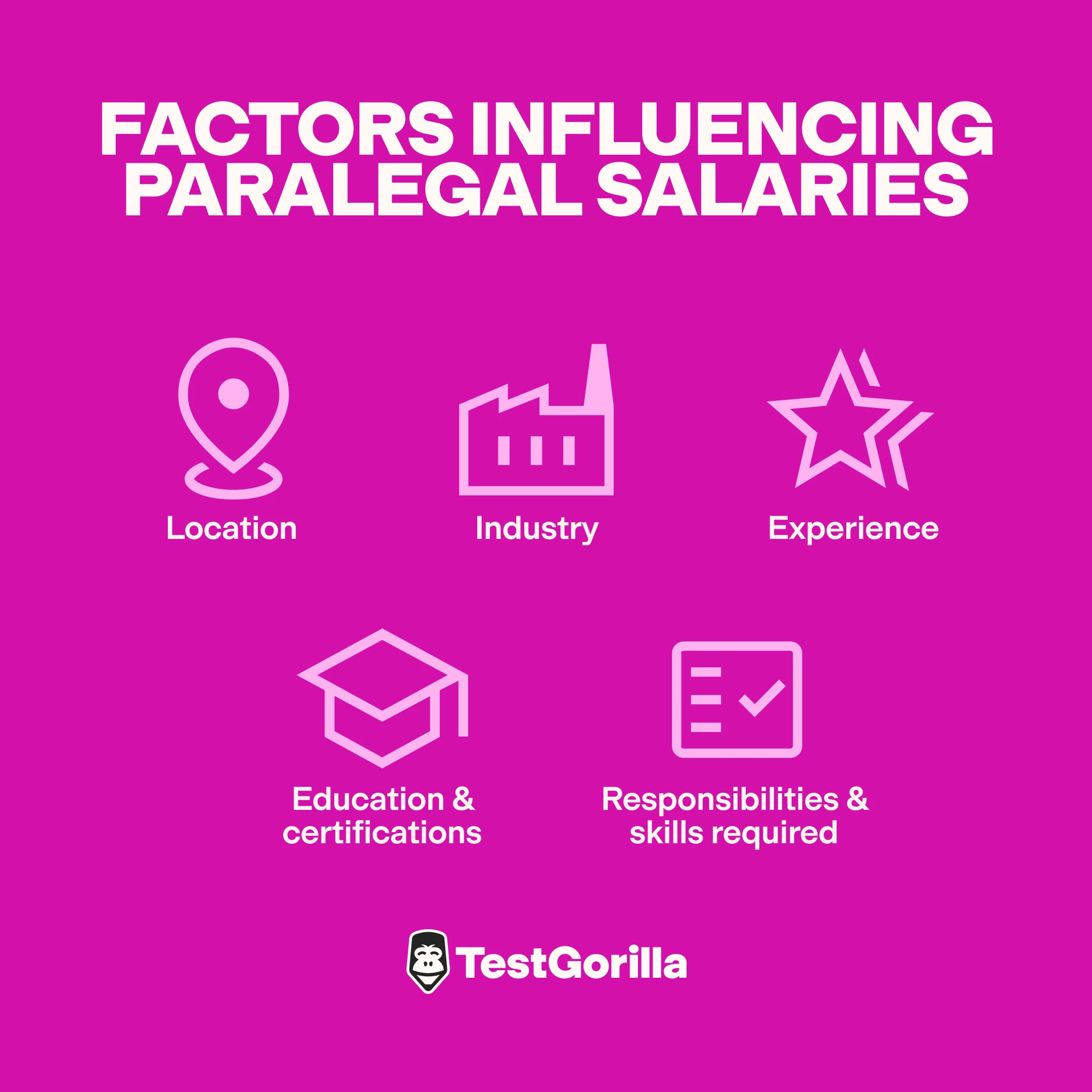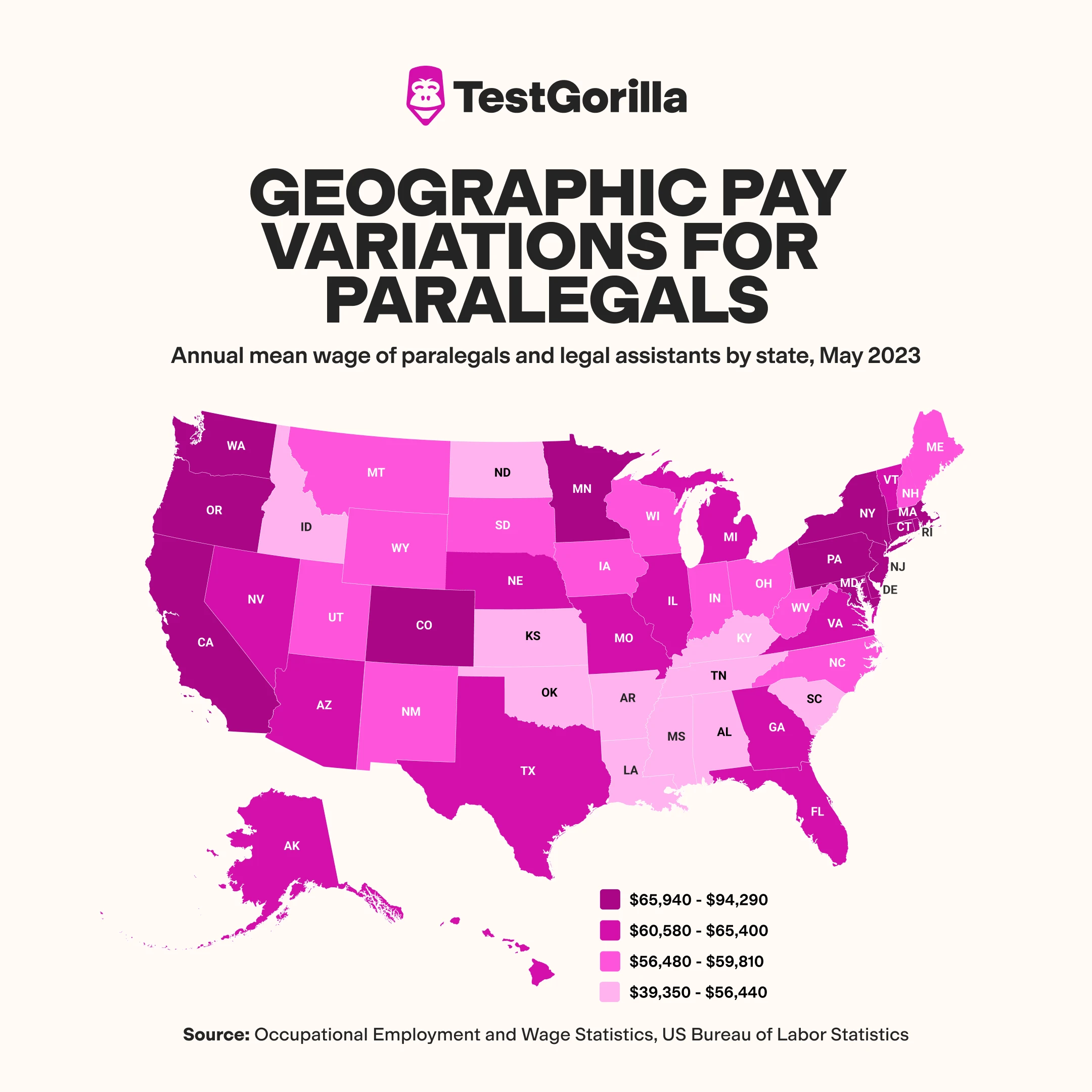Paralegals offer vital support to legal teams, but knowing what to pay them can be complicated. You must consider various factors, including the cost of living, their experience, and the industry in which they work.
Planning to hire a paralegal? Read on for our detailed guide to what to pay a paralegal to determine a competitive salary that attracts top talent without blowing your labor budget.
How we researched this topic
Most of the information in this article comes from the US Bureau of Labor Statistics’ Occupational Outlook Handbook on paralegals and legal assistants. The BLS gathers salary and wage data primarily through employer surveys – so it’s a reputable source of US-based pay.
We also rely on a 2020 survey by the National Association of Legal Assistants, the key industry body. This organization surveyed more than 6,000 of its members to source information on the pay and benefits paralegals receive.
Key takeaways
The average annual salary for paralegals in the US is $66,460 and the median salary is $60,970.
The location of a paralegal's office significantly impacts their earning capacity. For example, paralegals in Mississippi earn approximately 50.56% less than those in the District of Columbia.
The industry also influences the average paralegal wage, with finance/insurance and federal government roles being more lucrative on average.
The scope of the role and the qualifications and experience a candidate offers also impact the salary they receive.
In addition to their wages, paralegals often receive other benefits, such as retirement plans, conference fees, and life insurance.
The best insights on HR and recruitment, delivered to your inbox.
Biweekly updates. No spam. Unsubscribe any time.
National salary statistics for a paralegal
Here are several wage metrics for paralegals in the US, sourced from the BLS’s 2023 wage data:
Pay metric | Annual wage ($) | Hourly wage ($) |
Median annual wage | $60,970 | $29.31 |
Mean annual wage | $66,460 | $31.95 |
Bottom 10% earners | $39,710 | $19.09 |
Top 10% earners | $98,830 | $47.51 |
Median salary vs. mean salary
Mean and median wages are both useful metrics for understanding and comparing pay.
The mean salary is the average salary. It’s calculated by adding up the salaries of all paralegals and dividing the total by the number of paralegals.
The median salary represents the middle point at which half of paralegals earn more and half earn less. When hiring teams consider salary levels, the median salary is often a more informative measure of the average salary level. A handful of very low or high earners can easily skew mean salaries.
Factors influencing pay
Several factors might influence a paralegal’s salary or hourly pay.
These include:
Geography. Some areas in the US pay paralegals higher salaries than others, typically to account for the cost of living.
Industry. Average paralegal salaries vary depending on their industry. Government roles typically receive lower wages (except for the federal government).
Experience. Experienced paralegals are worth their weight in gold – and employers are willing to pay them accordingly.
Education and certification. While formal qualifications aren't always necessary, many paralegals have associate’s degrees in paralegal studies, and some become certified or seek higher education. This can increase their earning power.
Responsibilities and skills required. While some paralegals focus on administrative work, others have broader responsibilities – including drafting legal documents, dealing with clients, and managing projects – which increases their pay.
Geographic pay variations
Source: Occupational Employment and Wage Statistics, US Bureau of Labor Statistics
This map shows the annual mean wages of paralegals in each state, with the highest-earning states highlighted in dark blue.
The five areas with the highest annual mean wages for paralegals are:
District of Columbia ($94,290)
California ($79,210)
New York ($78,850)
Washington ($75,560)
Massachusetts ($74,710)
Looking more closely at this by metropolitan area, the top-paying regions are:
San Jose – Sunnyvale – Santa Clara, CA ($103,850)
San Francisco – Oakland – Hayward, CA ($92,860)
Washington – Arlington – Alexandria, DC – VA – MD – WV ($84,530)
Seattle – Tacoma – Bellevue, WA ($83,210)
New York – Newark – Jersey City, NY – NJ – PA ($80,240)
The five states with the lowest annual mean paralegal wages are:
Mississippi ($46,620)
South Carolina ($50,820)
Idaho ($52,980)
Kansas ($53,310)
Alabama ($53,450)
The cost of living explains the difference in paralegal mean annual wages across states. All five of the highest-paying states appear in the World Population Review’s top ten list of states with the highest cost of living. In contrast, three of the five lowest-paying states appear in the top ten states with the lowest cost of living.
For comparison, the World Population Review rates the cost of groceries in the District of Columbia as 106.9, while in Mississippi, it’s 97.1.
For reference, the national average is the baseline – set at 100. This means that the District of Columbia’s grocery costs are 6.9% above the average.
Housing costs in California (where the average paralegal wage is $12,750 higher than the national average) get an 186.5 rating, compared with 69.4 in Kansas (where the average paralegal wage is $13,150 lower than the national average).
Employers in high-cost-of-living states must offer better compensation to attract top talent, resulting in higher average annual salaries.
Another explanation for the difference in paralegal mean annual wages across states is that the higher-paying states, such as DC and New York, have large financial and corporate hubs. Compared with more rural states, these areas have a higher demand for legal services.
Industry-specific pay data
The below table sets out the highest and lowing paying industries for paralegals, along with the corresponding average annual salaries:
Industry | Annual mean wage ($) |
Higher paying industries | |
Finance and insurance | $77,630 |
Federal government (not including the postal service) | $74,380 |
Lower paying industries | |
Local government (not including education and hospitals | $61,240 |
Legal services | $59,660 |
State government (not including education and hospitals) | $51,420 |
High-paying industries for administrative assistants
The average annual wage for paralegals in the finance and insurance sectors is $11,170 above the national average, while federal government roles are $7,920 higher. A possible explanation for these differences? These sectors have higher budgets to spend on legal staff – especially the profit-driven finance and insurance sectors.
Lower-paying industries
The average wages for paralegals in local government, legal services, and state government are below the national average of $66,460. For example, the average annual salary for paralegals in the legal services industry is $6,800 lower than the national average, and in state government, it’s $15,040.
This is unsurprising given that private sector roles often offer higher compensation than the public sector.
Pay by experience and education.
According to a 2020 survey by the National Association of Legal Assistants (NALA), these are the average salaries for paralegals based on years of experience:
1 to 5 years: $44,110
6 to 10 years: $61,025
11 to 15 years: $68,080
16 to 20 years: $68,850
21 to 25 years: $73,381
25 years plus: $76,880
In most jurisdictions, paralegals and legal assistants aren’t required by law to have formal qualifications to work – though some employers may prefer these. There are various study options available to those wanting to hone their skills, including:
Certificate of paralegal studies
Associate’s degree in paralegal studies
Bachelor’s degree in paralegal studies
Master’s degree and PhD
Paralegal certification
Various educational institutions offer certificates and degrees in paralegal studies. Several professional bodies – including the NALA and the National Federation of Paralegal Associations (NFPA) – offer paralegal certification.
Interestingly, education plays a minor role in paralegal pay compared with experience. According to the NALA survey, average gross salaries by education level are:
High school/GED: $63,352
Associate’s degree: $61,734
Bachelor’s degree: $64,825
Master’s degree: $67,823
Paralegals usually can’t represent clients in court. However, several states – including Arizona, Oregon, Utah, and most recently, Texas – offer licensing programs that allow paralegals to represent clients on limited matters, usually family law-related. This effort aims to increase access to justice, providing low-income individuals with more affordable legal representation.
We expect that paralegals with this license may be paid more.
Pay by responsibilities and skills required
Paralegal roles can include a broad scope of administrative and quasi-legal tasks.
Legal assistants involved in more complex, quasi-legal tasks are typically paid more than those focusing on purely administrative tasks such as drafting correspondence or filing legal documents. More complex paralegal tasks include:
Legal research
Case analysis
Legal drafting
Investigating the facts of a matter
Taking affidavits from witnesses
Project management
More senior paralegals may also have management responsibility, overseeing a team of paralegals or legal assistants. These positions are also typically paid more to recognize the level of responsibility.
Benefits beyond salary
NALA’s 2020 paralegal survey asked respondents about the compensation and benefits they receive. It found the five most common benefits offered to paralegals by employers were:
Conference fees
Professional dues
Parking
Life insurance
Mileage
Continuing legal education is essential for anyone working in the legal profession, so, understandably, conference fees and professional dues are common benefits.
Most paralegal employers (73%) offer a retirement or pension plan, although the number has decreased compared with previous years. However, only 28% of employers offer profit-sharing plans, so this is a unique benefit you could consider offering.
The legal industry is notorious for its demanding work and long hours. Non-financial benefits that paralegals may like to support better work-life balance include flexible working hours, a formal time-off-in-lieu program, or remote work options.
Level up your hiring process with talent assessments
When hiring paralegal roles, the right compensation package is essential to attracting the best talent. Various factors influence paralegal pay levels, including location, years of experience, industry, and role responsibilities. You must also choose competitive benefits to include in your compensation package.
Setting the right pay level is essential for enticing candidates – but you also must make sure they have the right paralegal skills for the job. With TestGorilla, you can use skills-based assessments to ensure the person you hire meets the job's specific needs. This information justifies competitive salary packages and aligns the paralegal’s expertise and values with the organization’s.
Want to see how TestGorilla can help with your hiring? Sign up for an account today!
FAQs
What type of paralegal is the highest paid?
Senior paralegals with at least 11 years of experience receive the highest pay. Those with management responsibilities or who use high-level skills to work on complex matters (like case analysis) also usually demand more money.
Are most paralegals paid hourly or salaried?
There’s a roughly even split between paralegals paid by the hour and those who receive annual salaries. For example, it’s common for firms that use billable hours to pay their paralegals by the hour. In contrast, in-house or government paralegals usually receive a salary.
Where are paralegals needed the most?
California, DC, and New York have the highest demand for paralegals. As large tech, government, and finance hubs, these areas often have many paralegal roles available.
You've scrolled this far
Why not try TestGorilla for free, and see what happens when you put skills first.




















